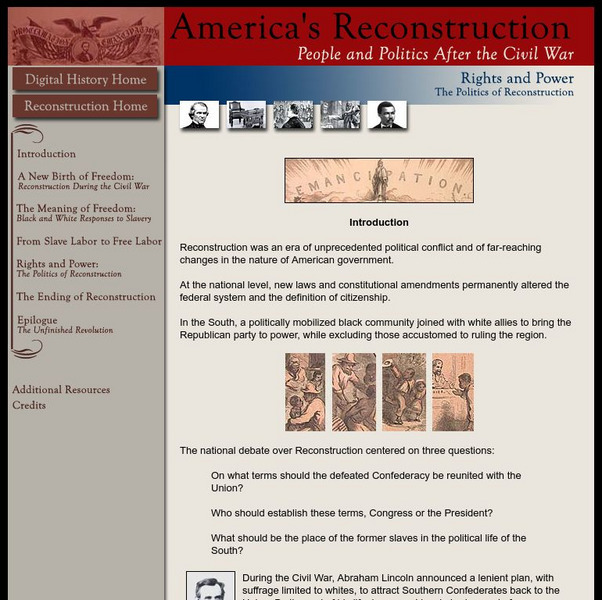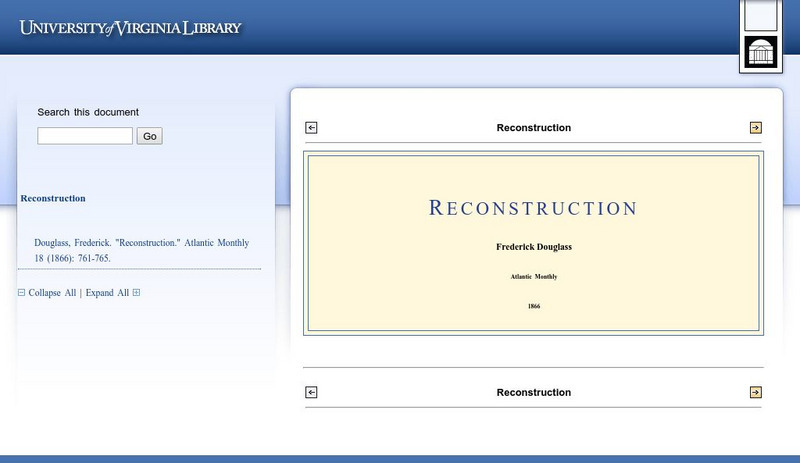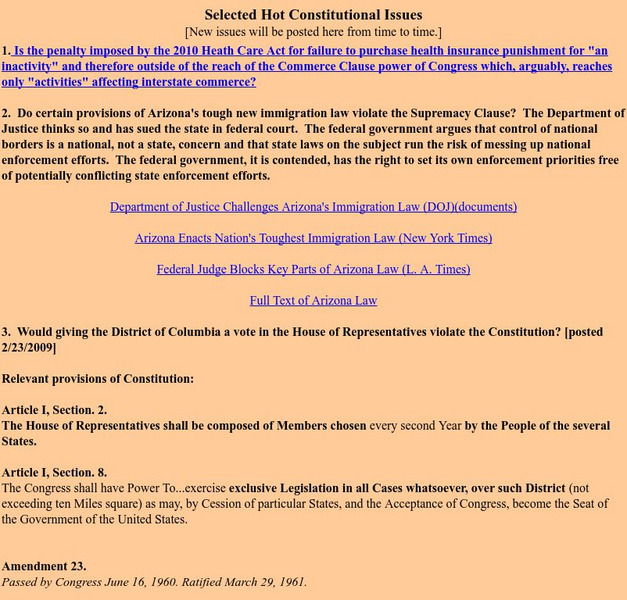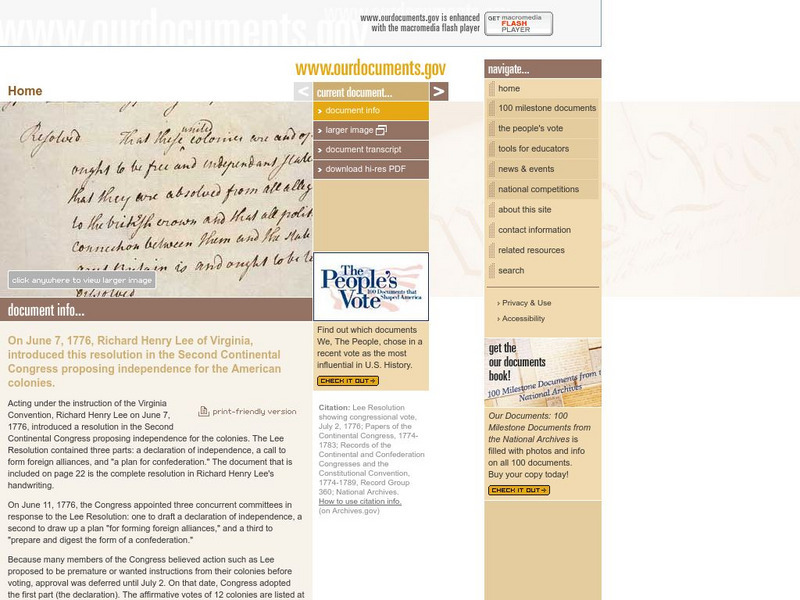Hi, what do you want to do?
Scholastic
Women's Suffrage for Grades 6–8
Learners study the decisions and solutions involved in winning the right to vote. After reading background information on the fight for women's suffrage, including one woman's story, and its eventual success in the United States and...
Curated OER
Women's Suffrage: Graphic Organizer
What were the long and short-term causes and effects of the United States' women's suffrage movement? Have learners fill in each of the four provided boxes on this graphic organizer to guide their focus when learning about suffrage.
Curated OER
Seneca Falls Convention: Declaration of Sentiments
The Seneca Falls Convention was an amazing outlet for the female voice during the time of women's suffrage. Learners will read a short, but powerful excerpt from the Declaration of Sentiment, as spoken at the convention. They'll answer...
Curated OER
The Constitution and the Right to Vote: Ch 6
The US Constitution dictates which members of society have the right to vote. After reading about amendments extending voting rights, your class answers these questions on the 15th, 14th, and 23rd amendments. Use as a quiz or to guide...
Curated OER
Emmeline Pankhurst, Why We Are Militant
Emmeline Pankhurst wrote Why We Are Militant in order to explain the plight of women during the time of suffrage. Learners read an excerpt from her work and answer one critical thinking question.
Curated OER
FAMOUS PEOPLE: SUSAN B. ANTHONY AND ELIZABETH CADY STANTON
Students explore websites are about Susan B. Anthony, Elizabeth Cady Stanton, and women's suffrage and read about how these women were important leaders in the movement that got women the right to vote.
Curated OER
The Right to Vote
Students discover voting barriers. In this government lesson, students explore the history of voting. Students work in small groups to analyze and debate if certain groups of people should have the ability to vote or not.
Forum Romanum
Outlines of Roman History: Times of Marius and Sulla:dictatorship of Sulla
In this section of a chapter in William Morey's 1901 textbook, you'll discover the changes Sulla made in the government of Rome.
Digital History
Digital History: America's Reconstruction: Rights and Power
This resource provides information about Reconstruction, the United States Government, slavery, and civil rights.
PBS
Pbs Learning Media: Civil Rights Special Collection
Multimedia collection of video, primary text documents and audio on Civil Rights, especially Brown vs. Board of Education.
Scholastic
Scholastic: Women's Suffrage
Find out about women's suffrage not only in the United States, but around the world. An interactive map displays the dates women gained their right to vote.
University of South Florida
Educational Technology Clearinghouse: Lit2 Go: Susan B. Anthony
Text of an article by Susan B. Anthony which was originally printed in "The Revolution," in 1868. The article is titled, "Is it a Crime for a Citizen of the United States to Vote?" The text can be read online or downloaded in either PDF...
University of Virginia
The University of Virginia Library: Reconstruction, by Fredrick Douglass
A document on Reconstruction written by Fredrick Douglass. He argues particularly for voting rights for blacks as the most necessary step to avoid the kinds of state's rights conflicts that brought about the Civil War.
University of Missouri
Exploring Constitutional Conflicts: Select Hot Constitutional Issues
Among other issues considered, Hot Constitutional Issues probes into the constitutionality of giving Washington, D.C. a vote in the House of Representatives, raised in 2009.
Savvas Learning
Pearson: Government by the People
An easy to follow flow chart that shows how the term "Government by the people," has changed over the years. Make sure to click on each box of information to get a more in depth description.
PBS
Pbs: Learning Media: Why Should Women Vote? The Suffrage Question
In this activity, students view eleven different documents arguing both for and against women's right to vote. They must click and drag them in the order that they were created. As they work, they need to make a list of the arguments...
Wikimedia
Wikipedia: Nineteenth Amendment to the United States Constitution
Learn about the 19th Amendment to the United States Constitution. It guarantees that a person cannot be denied the right to vote based on their gender. Includes discussion of Susan B. Anthony's and Elizabeth Cady Stanton's contributions...
US National Archives
Our Documents: 19th Amendment to the u.s. Const.
This site contains a good overview of the 19th Amendment of the U.S. Constitution. It gives background information on women's suffrage, provides the transcript of the actual document, and allows you to view an image of the document.
US National Archives
Our Documents: Wade Davis Bill(1864)
On this site you can view an original copy of the document and and also an easy to read version of the complete text. There is also a brief summary of the history behind the bill.
Library of Congress
Loc: Draft of Elizabeth Cady Stanton's "The Woman's Bible"
This article focuses on the philosophy and strategies of Elizabeth Cady Stanton, as well as the fight for women's right to vote.
Other
Feminist.com: Taking a New Look at the Woman Suffrage Movement
An article on the historical aspects of the women's suffrage movement, with a feminist viewpoint.
Other
Historical Society of Delaware: The Suffrage Movement in Delaware
The story of women and their fight for the right to vote in Deleware is described--and includes biographies of some Delaware women, a time line, and some primary sources.
The Dirksen Congressional Center
Congress Link: Voting Rights Act of 1965
Explores the Voting Rights Act of 1965 from the perspective of a Congressional leader. Presents an abundant amount of historical information about the origins of the Act as well as the steps needed to get it passed.
Smithsonian Institution
National Museum of American History: Separate Is Not Equal: White Only
This section from the Smithsonian Institution's National Museum of American History's exhibition Separate Is Not Equal: Brown v. Board of Education gives the history of Jim Crow laws and how they affected not only the voting rights of...
























